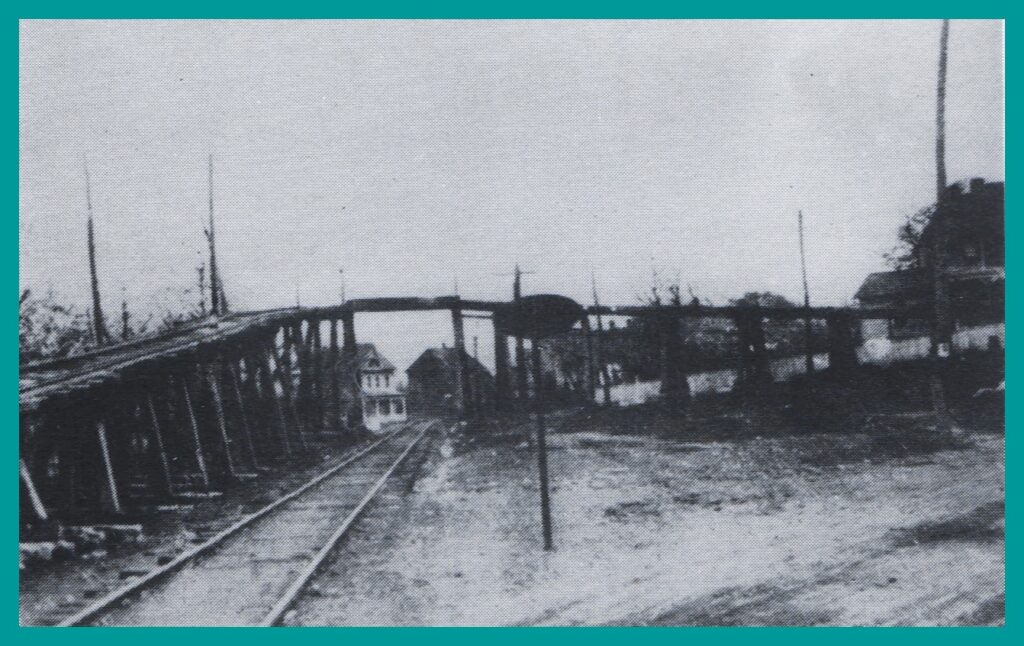An undated photograph of the trolley bridge at Wiconisco, Dauphin County, Pennsylvania.
The following story is from the Souvenir Book for the Wiconisco Sesquicentennial, 1839-1989:
THE TROLLEY LINE
During the late 1800s, the communities of the Lykens-Williams Valley area prospered due to the development of the mining industry. Collieries opened which provided plentiful employment, and, as a result the population tripled. Automobiles at this time were considered a luxury which very few could afford. The only rapid means of transportation existing among these communities were the few daily passenger trains of the Williams Valley Railroad.
Street railways were popular during this period and provided a convenient means of transportation commonly utilized between the smaller communities of the Commonwealth. On November 4, 1894, a group of Girardville and Asland residents obtained a charter under the name of the “Lykens Valley and Williams Valley Railway Company” to provide service for the residents of the valley from Reiner City (now Muir) through Tower City, Sheridan, Williams Township, Williamstown, Wiconisco, and Lykens, a distance of approximately 113 miles. The authorized capitalization was $100,000 consisting of 2,000 shares at $20 par, which exceeded the statutory requirement of $6,000 per mile of track. Since electrical energy was not then available, it is probable that the incorporators intended to operate horse-drawn cars on a regular schedule between the communities. However, in 1898, a power plant was erected at Williamstown and this new energy was utilized to give the communities rapid transportation instead of the horse-drawn vehicles.
Two overhead bridges spanned the line, one between Sheridan and the Dauphin County line, and the other in Wiconisco. The latter was built in 1903. These bridges carried the trolley over the tracks of the Williams Valley Railroad. As the trolley approached these structures, the motorman brought the vehicle to a halt, announced that all who did not wish to be transported across the bridges could alight and walk to the other side. Only the daring would remain aboard and brave the ride across.
A few of today’s [1989] senior residents can recall the stories told to them by their parents of the thrill of riding the “Toonerville,” as it was locally referred to. The ride was sometimes jolting, although the pace was always leisurely. Fares for dining on the trolley ran a whole twenty-five cents for transport from the beginning of the line at Reiner City to Lykens on the other end, five cents from Reiner City to Sheridan and ten cents to Williamstown. The cars of the trolley were enclosed in the winter and open in the summer and were sometimes so crowded that the passengers were required to stand on the outside platform and hang on by straps so thoughtfully provided by the management. Occasionally a pig wallowing in the mud was stuck between the tracks and straying cows were not infrequent casualties.
Apparently due to an accident, Tower City adopted an ordinance regulating the trolleys on June 4, 1917, and fixing the speed limit for trolleys through the borough at eight miles per hour. Sounding of the bell or gong within one hundred feet of the next intersection was also required and the trolleys were directed to run at no more than one hour intervals between 5:00 a.m. and midnight. This practice was followed on the routes through the adjoining towns. The town fathers probably accomplished their purpose in reducing speed, but the constant bell ringing surely must have disturbed the peace and slumber of the communities.
The trolley company was in operation until 1925, when it “gave up the ghost” because of competition of the automobile and the removal of the tracks when Route 209 was paved that year. Also in 1925, the trolley bridge in Wiconisco was torn down. A pillar segment from that bridge stands in the yard of Samuel Wynn and Linda Wynn and serves as a gentle reminder of the simple way of life which existed for those living here.
_______________________________________________________
Corrections and additional information should be added as comments to this post.
